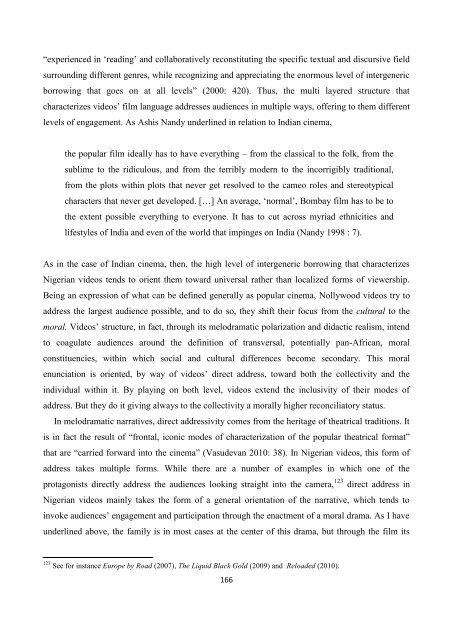Create successful ePaper yourself
Turn your PDF publications into a flip-book with our unique Google optimized e-Paper software.
“experienced in ‘reading’ and collaboratively reconstituting the specific textual and discursive fieldsurrounding different genres, while recognizing and appreciating the enormous level of intergenericborrowing that goes on at all levels” (2000: 420). Thus, the multi layered structure thatcharacterizes videos’ film language addresses audiences in multiple ways, offering to them differentlevels of engagement. As Ashis Nandy underlined in relation to Indian cinema,the popular film ideally has to have everything – from the classical to the folk, from thesublime to the ridiculous, and from the terribly modern to the incorrigibly traditional,from the plots within plots that never get resolved to the cameo roles and stereotypicalcharacters that never get developed. […] An average, ‘normal’, Bombay film has to be tothe extent possible everything to everyone. It has to cut across myriad ethnicities andlifestyles of India and even of the world that impinges on India (Nandy 1998 : 7).As in the case of Indian cinema, then, the high level of intergeneric borrowing that characterizesNigerian videos tends to orient them toward universal rather than localized forms of viewership.Being an expression of what can be defined generally as popular cinema, Nollywood videos try toaddress the largest audience possible, and to do so, they shift their focus from the cultural to themoral. Videos’ structure, in fact, through its melodramatic polarization and didactic realism, intendto coagulate audiences around the definition of transversal, potentially pan-African, moralconstituencies, within which social and cultural differences become secondary. This moralenunciation is oriented, by way of videos’ direct address, toward both the collectivity and theindividual within it. By playing on both level, videos extend the inclusivity of their modes ofaddress. But they do it giving always to the collectivity a morally higher reconciliatory status.In melodramatic narratives, direct addressivity comes from the heritage of theatrical traditions. Itis in fact the result of “frontal, iconic modes of characterization of the popular theatrical format”that are “carried forward into the cinema” (Vasudevan 2010: 38). In Nigerian videos, this form ofaddress takes multiple forms. While there are a number of examples in which one of theprotagonists directly address the audiences looking straight into the camera, 123 direct address inNigerian videos mainly takes the form of a general orientation of the narrative, which tends toinvoke audiences’ engagement and participation through the enactment of a moral drama. As I haveunderlined above, the family is in most cases at the center of this drama, but through the film its123 See for instance Europe by Road (2007), The Liquid Black Gold (2009) and Reloaded (2010).166
















